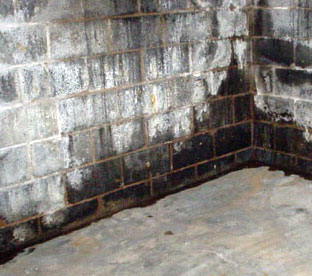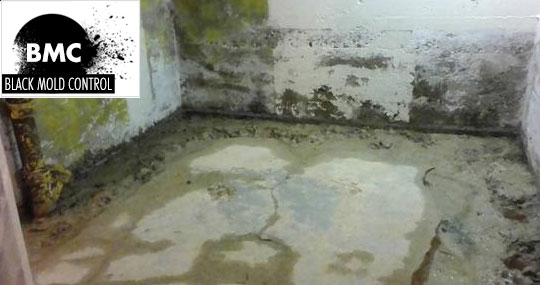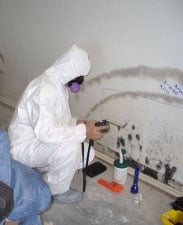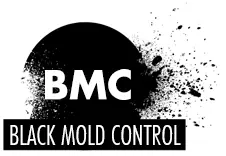
Don’t ignore the problem
Molds are not just unsightly; they can cause structural damage and might make you sick. Black molds may be Stachybotrys, possibly S. chartarum or S. chlorohalonata. Many molds can take up residence in your home. Not all are black; they might be yellow, white or some other color. It’s important to understand and identify molds. Prevent them, if you can, and take steps to get rid of them quickly.
Table of contents
Causes for black mold in basement
Molds are fungi. They thrive in environments with a high humidity level and put off a musty smell. They are beneficial in nature, helping leaves and other vegetation decompose and enrich the soil. Molds are everywhere and come in many colors — green, blue, yellow, white, gray and black. Molds reproduce by putting off tiny spores — seed-like organisms that travel through the air. The spores settle on organic materials including food, cardboard, carpeting, fabric, plants, insulation, wood, ceiling tile, drywall, and even cinder blocks and grow — if conditions are right, they grow. If you don’t get rid of them, you can have significant problems!
Types of mold
There are perhaps as many as 300,000 species, according to the Centers for Disease Control (CDC). It can be difficult to identify types, but you may be able to get an idea based on color. Green, blue or white molds may be Penicillium. Yellow, black or green may be Aspergillus. Alternaria, a common outdoor variety, may be black or gray. Of all them, the most feared are the greenish-black organisms of the genus Stachybotrys. Yes, these infamous “black molds” may be responsible for sick building syndrome and other health problems. Scientists have identified about 50 species of Stachybotrys.
White mold
White mold is a type of fungi that thrives in humid environments. Now, most people think it stays white, but that’s not always the case. It can turn green, gray, black, or any other color. The appearance it takes depends on the material it feeds on. Plants, food, wood, and even fabrics are the common targets, and it’s hard to identify in its early stages as it is microscopic. However, once it multiplies, it becomes visible. It can have a stringy, flaky, or even powdery texture.
If you are exposed to the spores for a long time, it may cause allergic fungal sinusitis, allergic bronchopulmonary aspergillosis, asthma, and other respiratory ailments.
Fungi grow well in damp spaces with temperatures between 2 and 40 degrees Celsius. Basements are normally at a much lower temperature than the rest of the house, which during summer months, create the perfect atmosphere for fungi growth. When the warm air of the outside comes in contact with the colder walls, it condenses, resulting in a moisture-covered room.
Green mold
Green mold is a type of fungi that has a green color, powdery, soft or flaky texture and is often found on fruits and bread. Still, it can do more than threaten your food. It can also get inside your house and make any humid areas its home. Penicillium, Cladosporium, and Aspergillus are a few of the genera covering the green-looking type. This type of fungi is also dangerous. Penicillium, for example, produce spores that are toxic to people. Asthma, allergies, and other respiratory problems may appear when exposed to the toxins for a prolonged period of time.
Like the white type, the green one can sneak into a basement with ease. Remember, a humid environment is necessary for any type to survive, and leaking pipes, heavy rainfall, damp soil, and poor ventilation are factors that lead to its growth.

Mold on basement walls
Basements are the preferred spots for black mold to grow. Almost no ventilation, plenty of moisture, and a vast amount of organic material to feed on, make the process of keeping the area clean difficult. If the wall is made of concrete and has black patches, it means there’s organic material nearby that keeps feeding it. That material could be carpets, newspapers, cardboard boxes, and even furniture. Get rid of all contaminated items at once before attempting to remove the fungi from the walls.
Remember to use a safety mask, goggles, rubber gloves, and other protective gear to reduce exposure to the toxic spores that are released by it and the chemicals used to remove it. The next step is scrubbing. Scrubbing with water and soap will prepare the wall for the later application of specialized fungi removal products. After using the water and soap mixture, it’s time to use the chemicals such as hydrogen peroxide or borax. Hydrogen peroxide and water can make a safe and effective solution to eliminate the fungi. Borax, when mixed with water, can also be used to scrub the walls, and it doesn’t even need to be rinsed. Once you are done, dry the walls to keep moisture away. A dehumidifier or an open window can help keep the air moving. If the task seems too daunting, get a free quote and hire a professional.
Mold on basement floor
Black mold can also take over the basement floor. It can be caused by leaking pipes, poor drainage or lack of ventilation. To eliminate it, fill a spray bottle with water and spray the floor, then scrub the floor with a stick scrub brush as much as possible. Then, mix water with ammonia in a bucket, and use a scrub brush to clean the floor. Once done, use water to remove all the remaining soapy water from it. Next, prepare a mix of bleach with water and scrub again. Leave the bleach for several minutes and then clean again with plain water to remove the bleach. Dry the floor ensuring to remove all moisture from it. Finally, use a dehumidifier to keep the area moisture free.
How to get rid of black mold in basement
 You may have different kinds of molds in your basement. You should get rid of them whether they are yellow, white, green, blue or black.
You may have different kinds of molds in your basement. You should get rid of them whether they are yellow, white, green, blue or black.
- Step 1: Remove everything from your basement and make sure it is dry before you try to get rid of your problem. If your insulation, ceiling tiles or drywall are moldy, replacement is your only option. But if it’s only on the surface of painted ceilings, walls, and floors, you should be able to clean it off with a bleach solution. The CDC recommends no more than 1 cup of bleach to 1 gallon of water. Commercial removal products may also be useful.
- Step 2: You can scrub cinder blocks and concrete walls and floors with the same solution. You will need to let it soak into cracks and crevices to kill the black mold. Once you get rid of it, and the walls and floor are dry, you can use a sealant and paint. Be sure you have adequate ventilation while working in the basement and wear gloves while cleaning.
- Step 3: As you plan for removal, consider steps to prevent further problems. Do whatever you can to maintain control over the humidity level and ensure ventilation in the future.
- Step 4: And remember to clean everything you return to your basement. If you have items, such as cardboard boxes, with a musty smell, toss them and get new ones. Compared to starting over, the cost for this black mold clean-up will be small.
Basement mold removal cost
If you desire to get rid of the mold by yourself, the cost, for the most part, will be based on the products you use. Bleach, vinegar and hydrogen peroxide are cheap and effective to tackle small projects. If you have a small basement, around 10 square feet, the removal process can be done for around $50. A severe infestation within a large area may end up costing between $500 to $3000 and between $2100 to $6200 to seal the foundation and prevent future problems.
The removal of the fungus is not expensive and can be done by homeowners if the area is small. However, doing so does not guarantee that it won’t come back, and in the case of black mold, it is likely that it will return unless all preventive measures have been taken. Failing to remove it may result in increased future costs. If you are not sure how to do it or the infestation is too large, always hire a professional.
How to prevent black mold in basement
Once you have it in your basement, it is very hard to get rid of, and it creates problems that may cost you a lot. Your best course is to prevent the problem. Controlling moisture and the humidity level of your basement is most important.
If you notice a musty smell, check for moisture. Is water seeping in through the cinder blocks? Do you have a leaky pipe? Is your drywall damp? Are there dark splotches on the walls or ceiling? Fungi grow fast in moist, humid conditions, so do regular checks of your basement if it’s a space you don’t often visit.
You may want to invest in a dehumidifier. The cost will be minimal compared to the expense of clean-up and removal. Airflow is necessary, so don’t stack items to the ceiling or very close to walls. Use an exhaust fan or open doors or windows when weather permits. Fungi are attracted to organic material, so don’t grow plants or store firewood in your basement.
